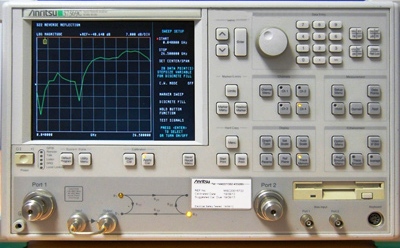
|
|
The Anritsu 37369C 40 GHz Lightning Vector Network Analyzer (VNA) is a high performance tool designed to make fast and accurate S-parameter measurements of active and passive devices across the 40 MHz to 40 GHz range. The network analyzer integrates a synthesized source, S-parameter test set and tuned receiver into a single compact package that is ideal for bench-top testing. High throughput measurements are achieved in each model through the use of fast, 12-term error corrected sweeps, fast GPIB data transfers and an intuitive user interface. All measurement results are displayed on a large LCD color display or on an external VGA monitor. Specifications. Frequency Range: 40 MHz to 40 GHz. Dynamic Range ("Receiver Dynamic Range" is defined as the difference between the maximum signal level at Port 2 for 0.1 dB compression and the noise floor. "System Dynamic Range" is defined as the difference between the power incident on Port 2 in a through line connection and the noise floor. High Level Noise (typical): <0.04 dB and <0.5 degrees peak-to-peak variation in a 1 kHz IF bandwidth up to 20 GHz. Max Signal Into Port 2: 30 dBm. Noise Floor: -65 dBm @ 0.04 GHz, -83 dBm @ 40 GHz, Max. -93 dBm @ 2 GHz. Receiver Dynamic Range: 95 @ 0.04 GHz, 113 @ 40 GHz, Max. 123 @ 2 GHz. Port 1 Power: 0 dBm @ 0.04 GHz, -7 dBm @ 40 GHz. System Dynamic Range: 70 @ 0.04 GHz, 76 @ 40 GHz, Max. 98 @ 2 GHz. Measurement Time vs. Span for 101 Data Points (typical): 40 MHz to 40 GHz, 450 ms. Number of Channels: Four independent measurement channels. Parameters: S11, S21, S22, S12, or user-defined combinations of a1, a2, b1, and b2. All measurements are made without the need to manually reverse the test device. Display LCD, Color, 8.5-inch diagonal. Options. Opt 1, Slide Rack Mounting. Opt. 1A, Rack Mounting. Opt 2A, Time Domain (Microwave Units). Opt 2B, Time Domain (RF Units). Opt 4, External SCSI-2 Hard Disk Drive Compatibility. Opt 7A/N/NF/S/K, Universal Test Port Configuration, Replaces Universal / K Connector (standard) with: 7A - Universal / GPC-7, 7N - Universal / N, male, 7NF - Universal / N, female, 7S - Universal / 3.5 mm, male. Opt 10A, High Stability Ovenized Time Base and 1 Hz Resolution.
|